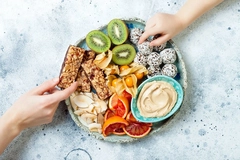27 Jan 2016 --- Key factors driving the top 2016 Japanese foods trends are regulatory and demographic changes as well as product development innovation. “The most popular trend will be the increased launch of premium products with unique ingredients. This is evident in the ice cream market, one of our chosen trends this year,” Yuko Kobayashi, food ingredients marketing associate at Nagase told FoodIngredientsFirst.
Michael Moses, marketing manager, Nagase America told FoodIngredientsFirst: “These trends are in-line with consumer demands with products that meet their demands for health, convenience and indulgence.”
Kobayashi adds: “One of the features of the Japanese market is a large amount of product launches based on holidays and seasons, meaning that food fads change quickly. Another key feature is the idea of blurring borders, the blurring of lines between Japanese and non-Japanese food, hybrid pastries, and even flavors, such as sweet and salty.”

Functional Food and Beverages 2.0
In 2015, the Japanese Consumer Affairs Agency amended the health claims system for food and beverages, which is expected to profoundly impact the activities of food and ingredient manufacturers in 2016.
Moses says: “Yuzu has a bold citrus profile and is very popular in Japanese beverages, confections, in spices, and more. As citrus is one of the most popular flavors worldwide, yuzu has a place to play globally where consumers want flavor profiles that play on favorites but with an exotic twist. Other Japanese fruits, such as persimmons, could appeal to consumers globally as well.”
For the first time, this updated system allows function claims, in addition to the previously allowed nutrient and FOSHU (Foods for Specified Health Uses) claims. Unlike FOSHU, products with function claims do not require individual preapproval, and claims can now be made based on scientific reviews of the functional ingredients the product contains. As of last December, there were 149 products for which premarket notification for function claims were sent, and the list is expected to grow in 2016. An important prediction is that ingredients with both technical and health benefits will be featured more prominently on food product labels as manufacturers aim to produce delicious foods with function claims. An example is lutein, which has the technical benefit of being a coloring agent, while also having health benefits, such as playing a role in supporting eye health.
Unique Ice Cream and Frozen Treats
From 2005 to 2014, sales of ice cream grew over 20% in the Japanese market, according to a survey by the Japanese Ice Cream Association. “Ice cream manufacturers are generating consumer interest by innovating with non-traditional ingredients and flavors, such as cream cheese and Mont Blanc cake,” says Kobayashi. “Unique frozen treats will continue to drive market growth in 2016 with unique flavors and toppings, non-dairy ice creams, frozen ice cream-confectionery fusions, and more,” she adds.
Moses says: “One of the key drivers of increased sales is the growing popularity of higher-priced premium ice creams. As Japan’s population ages, frozen treat manufacturers are increasingly focusing on adults with premium product launches, whereas ice cream traditionally was seen a snack for children. This has been a way brands have increased total sales in a country with a shrinking population.”
Universal Design Foods
Universal design foods are foods formulated to be easy to eat by all types of people, including everyday meals and foods formulated for the elderly. These foods bear a logo that includes a ranking for the ease of chewing the food. Example products include canned peaches or pureed pork and vegetables. “Universal design foods showed increased sales of 86% between 2009 and 2013, according to the Japan Food Care Conference” Kobayashi adds.
by Elizabeth Kenward













